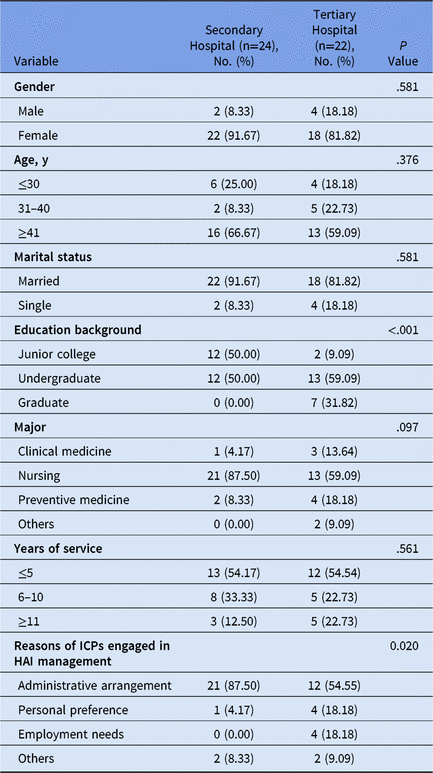To the Editor—Healthcare-associated infection (HAI) management is an important component of medical quality management; it directly affects the quality of healthcare and patient safety.Reference Rodríguez-Baño, del Toro, López-Méndez, Mutters and Pascual1 With advances in medical technology, the HAI problem has become more and more prominent, which has put forward higher work requirements for infection control professionals (ICPs). More than 40 years ago, the Centers for Disease Control and Prevention (CDC) conducted the national Study on the Efficacy of Nosocomial Infection Control (SENIC).Reference Haley, Quade, Freeman and Bennett2 Its findings suggested that an adequate staffing ratio of ICPs had lower rates of HAI. Similarly, a number of other studies reported that high levels of ICPs played an important role in reducing HAI rates.Reference Parry, Tucker and Tarnow-Mordi3, Reference Richet, Benbachir and Brown4 To our knowledge, little information is available regarding the current status of ICPs in China published in the English language.
In January 2019, we collected the demographic characteristics and occupational statuses of 46 ICPs from 5 tertiary hospitals and 16 secondary hospitals where independent nosocomial infection and control departments had been set up. Demographics and work situations of ICPs are shown in Table 1. Among the investigated ICPs, 86.96% were female, and 63.04% were aged ≥41 years. Most ICPs had taken undergraduate courses (69.57%) and were in a nursing specialty (73.91%). Except education background, the differences in gender, age, marital status, major, and years of service were not statistically significant between ICPs in secondary and tertiary hospitals (P > .05). Surprisingly, the most common causes for engaging in HAI management were administrative arrangements, which accounted for 71.74%.
Table 1. Demographics and Work Situations of Infection Control Professionals (ICPs) in Wuhu City

The ICP teams were mainly composed of female nurses. This composition is consistent with the findings from other cities in China concerning ICP characteristics.Reference Zhang, Han and Yang5, Reference Zhang, Zhang, Jin and Zhang6 A few hospitals hire retired nurses to ensure the quantity of ICPs in accordance with the requirements.Reference Sun7 However, the proportion of nurses will gradually decrease in the future. As the prevention, management, and control of infection have developed, most hospitals have begun to recruit candidates from a wide range of clinical or healthcare-science backgrounds, especially public health graduates. Vassallo et alReference Vassallo and Boston8 proposed that those hiring ICPs should consider masters of public health graduates as candidates whose epidemiologic skills could help to drive the future of this profession in decreasing HAIs and promoting patient safety and service quality.
Moreover, most ICPs had worked <5 years, which reflects the instability of the management team. Most ICPs were engaged in HAI management due to administrative arrangements. Previous studies have suggested that the main causes of the instability in the management team are heavy workload, insufficient leadership attention, and low pay in China.Reference Zhang, Han and Yang5, Reference Zhang, Wei and Wang9 Only by solving these problems can we cultivate high-quality ICPs.
In conclusion, the HAI management team in Wuhu city has basically formed. The structure of ICPs in tertiary hospitals is better than that of secondary hospitals, but the personnel structure is still unreasonable, and the professional level needs to be further improved.
Author ORCIDs
Peijin Zhang MM, 0000-0001-7323-2804
Acknowledgments
We would like to thank the Nosocomial Infection Control Center of Wuhu City for supporting the study.
Financial support
No financial support was provided relevant to this article.
Conflicts of interest
All authors report no conflicts of interest relevant to this article.



